USS MULLINNIX DD-944
Med
1 May - 9 November, 1970
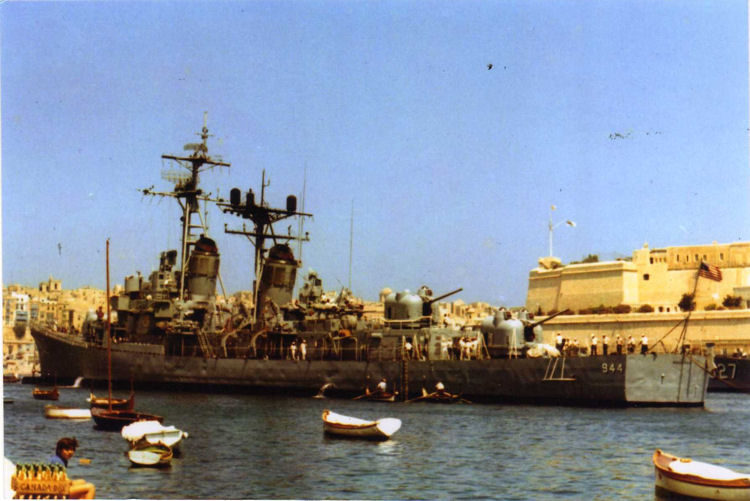
Mullinnix in Grand Harbour, Malta (1970)
________________
Excerpt from "The Last Gun Ship - History of USS Mullinnix DD-944"
A Historical Novel By Frank A. Wood
1 May saw Mullinnix leave D&S Piers for her next Med cruise, anchoring in Pollensa Bay, Mallorca, Spain on 12 May. The CO, XO, several additional officers and selected crew members left the ship for a "turnover conference" with the USS Storm DD-758. Once the party returned to the ship, she pulled anchor and steam out of the anchorage. She arrived in Athens, Greece on 15 May, achoring in the bay.
On 18 May, she steamed out of Phaleron Bay (Athens), and headed east towards the Black Sea aned Black Sea Operations. On 19 May at 0448, she exchanged call signs visually with station at entrance to Dardanelles. At 0747 the ship complated transit of Strait of Dardanelles. At 1551 Mullinnix set the special sea and anchor detail in preparation for entering The Bosporous.
At 0814 on 21 May, Mullinnix was buzzed by a Beagle Class Soviet jet. By 1036, she was being shadowed by a Riga Class Soiet destroyer escort. At 1040, she was buzzed again by another Beagle Class Soviet jet. These Soviet jets were making photographic runs at Mullinnix. At 1745, things started getting more interesting as an unknown Soviet aircraft passed down starboard side at about 10 miles range. By 1755, this aircraft was ID'd as a Bear Bravo class aircraft. And yet again, at 1835, the ship was overflown by two Badger Bravo Class Soviet jet bombers.
By 23 May, Mullinnix was in position to return back to the Western Med via The Bosporous. At 1751, she was entering the Sea of Marmara. On 25 May, Mullinnix was refueling in Souda Bay, Crete, then leaving the same day back to fleete operations and Beauliev, France.
At 1047 on 26 May, General Quarters was sounded due to a fire in the forward port life jacket locker on the main deck. Fire was extinguished and flash watch set.
She anchored in Beaulieu, France (a seaside commune on the French Riviera between Nice and the Principality of Monaco) 0n 28 May, leaving on 3 June. On 4 June, the ship moved to and moored at Ville Franhe, France (immediately to the east of the city of Nice). Mullinnix went back to fleet operations on 8 June. 15 June found the ship in Valletta, Malta, leaving on Indepence Day, 4 July. After a week of fleet ops, she was back in Valletta on 11 July. She was back to work on 18 July.
A full power run was attempted on 19 July but with a number of issues, Mullinnix on made it 3 turns past 28 knots.
Deck logs imply that the ship was steaming towards Pollensa Bay, Majorca but there is no record of the ship stopping there. By 24 July, Mullinnix was back in Athens, Greece. It was back to fleet operations on 3 August. 11 August, she was moored in Grand Harbor, Malta (Port of Valletta).
On 10 August, Mullinnix steamed out of Malta headed towards Pautelleria, Italy, anchoring on 19 August. After a short visit, she left on 20 August. 26 August found Mullinnix back in Athens, Greece. The crew's opinion was they couldn't get enough of Athens. The ship left Athens on 6 September.
After additional exercises with the 6th Fleet, Mullinnix moored in Bizerte, Tunisia on 11 September. After 3 days, it was back to sea on 14 September. It was back to Souda Bay, Crete on 25 September. She left Souda Bay on 12 October, steaming to participate in Exercise Deep Express. She arrived at Cape Dheftero, Greece on 14 October, anchoring in 50 fathoms of water with sand bottom, staying only one night. The ship anchored in Alexandropolus @ 0228 at Naval Gun Fire Support Anchorage. Mullinnix was underway on 18 October to participate in Operation Deep South. On 24 October, the ship anchored in Riposto, Sicily. 26 October found Mullinnix back at work.
GO TO Liberty Call Athens, Greece 1970
GO TO Liberty Call Beaulieu, France 1970
GO TO Liberty Call Valletta, Malta 1970
GO TO Liberty Call Pantelleria, Sicily 1970
GO TO Liberty Call Bizerte, Tunisia 1970
GO TO Liberty Call Souda Bay, Crete 1970
GO TO Liberty Call Alexandropolus, Greece 1970
GO TO Liberty Call Riposto, Sicily 1970
GO TO Liberty Call Cagliari, Sardinia 1970
GO TO Liberty Call Barcelona, Spain 1970
On 27 October, she anchored at Cagliari, Sardinia. Italian Navy Divers recovered 20' of mooring line from the port propeller shaft. The ship left the following day. She moored in Barcelona, Spain on 29 October at 0940. With the last liberty port behind them, the crew headed home to Norfolk, VA on 1 November. At 1503 on 9 November, Mullinnix moored to berth 202, D&S Piers, US Naval Station, Norfolk, Virginia with standard mooring lines doubled.
______________
I was waiting for the Mux’s return from the Med in Norfolk. I mess-cocked on base for about 6 wks waiting, and waiting, and waiting... Another 2 wks earlier and they would have flown me to the Med to catch the Mux. FTG3 Greg Berry reported aboard about 4-5 weeks ahead of me and they did indeed fly him over to the Med to catch the ship. What a way to start a Navy career. I spent 3 ½ years on the Mullinnix and not once made a Med cruise – simply amazing.
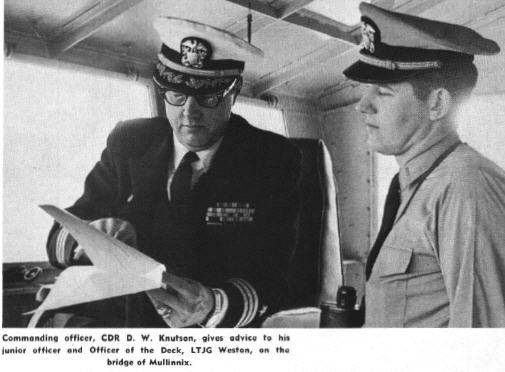
Mullinnix CO Knutson and LTJG Weston on Mux Bridge
All Hands Magazine, June 1970


Making of An OOD (Mullinnix Style)
Story by JO2 Robert R. Little, USN; Photos by PH2 Rick Omelchuk, USN
All Hands Magazine - September 1970
 HEN HE Was in Navy ROTC, Stephen F. Weston entertained thoughts of conning a destroyer. The idea recently became a reality when Lieutenant (jg) Weston qualified as Officer of the Deck on board USS Mullinnix (DD-944).
HEN HE Was in Navy ROTC, Stephen F. Weston entertained thoughts of conning a destroyer. The idea recently became a reality when Lieutenant (jg) Weston qualified as Officer of the Deck on board USS Mullinnix (DD-944).
The accomplishment did not come easily. After he was graduated from the University of Mississippi and received his commission, it took two years of hard work and study to qualify as OOD. And LTJG Weston is justifiably proud of his new status.
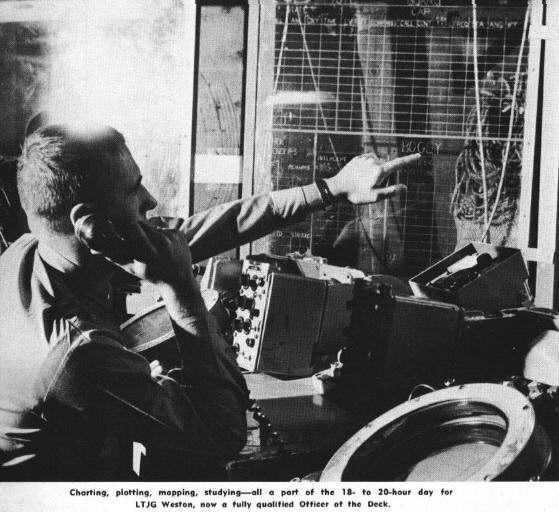
As an OOD, LTJG Weston is the most important man on the ship when he has the conn, regulating all shipboard life from reveille, meals, and taps, to ship-board drills and exercises with other U.S. Navy units or ships from other nations.
A big job.
Traditionally, destroyers have been regarded as a young man’s ship and qualifying as an OOD aboard a greyhound is considered by many to be synonymous with making the grade as a true Navyman.
 HERE’S LITTLE QUESTION about it: training aboard today’s sophisticated destroyer is difficult - "tougher than college (and) tougher than Officer Candidate School," believes LTJG Weston.
HERE’S LITTLE QUESTION about it: training aboard today’s sophisticated destroyer is difficult - "tougher than college (and) tougher than Officer Candidate School," believes LTJG Weston.
He began learning about the complexities of running a destroyer the day he reported on board.
"I was told," says Weston, "that no other branch of service places so much responsibility in the hands of a junior officer as the Navy does in its OODs. I believer it."
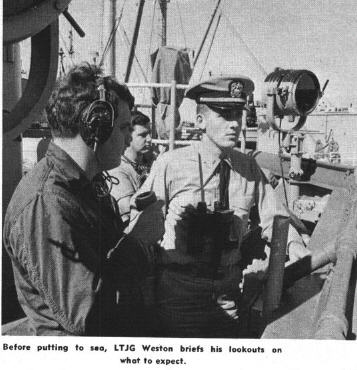
The responsibility a young naval officer carriers is indeed heavy. But, it is generally welcomed by aspiring individuals, because it gives them a chance to demonstrate their abilities at an early age.
The junior officer at sea who has qualified as an OOD has complete operational control of his ship. When he has the conn, he is responsible for the ship and for the lives of the men on board.
To reach such a status, an officer is required to complete an OOD training program. Mullinnix’s program is divided into four phases: engineering, combat information, bridge orientation, and practical examinations.
 NASMUCH AS EACH destroyer has its own OOD training program. Mullinnix officers are additionally required to complete schooling in antisubmarine warfare, firefighting, damage control, emergency ship-handling, and Rules of the Nautical Road.
NASMUCH AS EACH destroyer has its own OOD training program. Mullinnix officers are additionally required to complete schooling in antisubmarine warfare, firefighting, damage control, emergency ship-handling, and Rules of the Nautical Road.
LTJG Weston’s training began in the engineering compartments where he studied the ship’s engineering plant and machinery operation. He studied and memorized engineering instructions and the ship’s standing department orders.
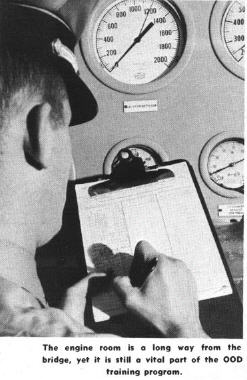
He learned the locations and functions of all main piping associated with engineering control and all main propulsion machinery and associated equipment. Then, he had to prove he knew how it all worked.
In the second phase of training, the lieutenant moved to the Combat Information Center - CIC - where all information necessary for the ship to function as a combat unit is evaluated.
To the naval officer it meant more study of instructions on Rules of the Nautical Road. It also meant he had to master voice radio communications and become familiar with signal books and the procedures to be followed when maneuvering with allied ships.
The latter presents the OOD with many challenges, and such exercises often provide additional training for the NATO forces.
 HILE STANDING CIC watches, LTJG Weston had to determine the course and speed of Mullinnix during fleet maneuvers, pilot the ship into port, anchor by radar, and operate air and surface search radar equipment. He also reported on procedures to be followed during simulated training exercises.
HILE STANDING CIC watches, LTJG Weston had to determine the course and speed of Mullinnix during fleet maneuvers, pilot the ship into port, anchor by radar, and operate air and surface search radar equipment. He also reported on procedures to be followed during simulated training exercises.
The third phase of training was on-the-job as a junior OOD. Linked to this were many hours of brushing up on previous training, and learning minute details about weather observations and how to navigate the ship by celestial bodies.
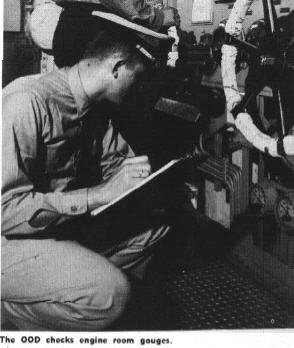
Final OOD training consisted of a standard written examination given by the Navy, and a practical exam administered by the ship's commanding officer.
This last hurdle include controlling the ship in restricted waters, mooring alongside piers, getting underway, anchoring the ship, conducting man overboard drills and underway replenishment, maneuvering in formation, and navigating the ship by electronic equipment and the stars.
LTJG Weston made the grade.
Now, when he is not at the helm, he is catching up on his paperwork or supervising his division, or reviewing what he has already learned, or discussing problems with other OODs.
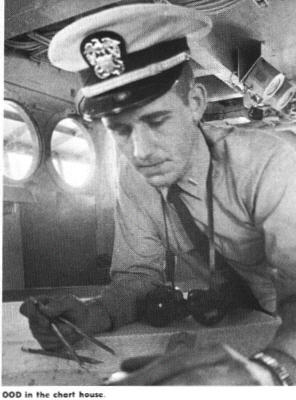


Stars & Stripes, 9 Aug 1970
Mullinnix Finishes Tour of Black Sea


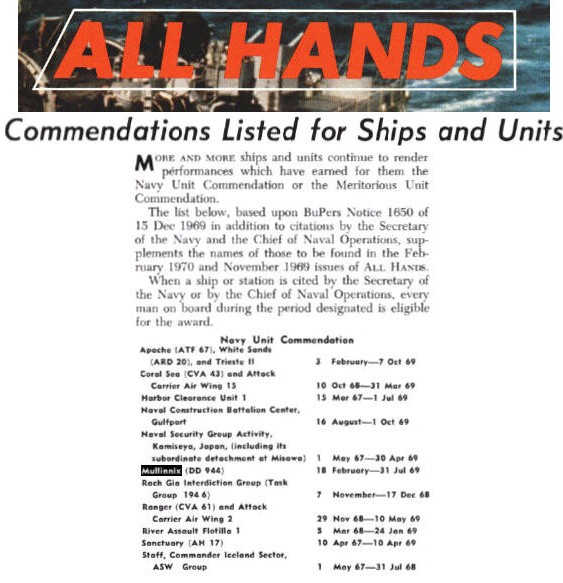
All Hands Magazine - June 1970


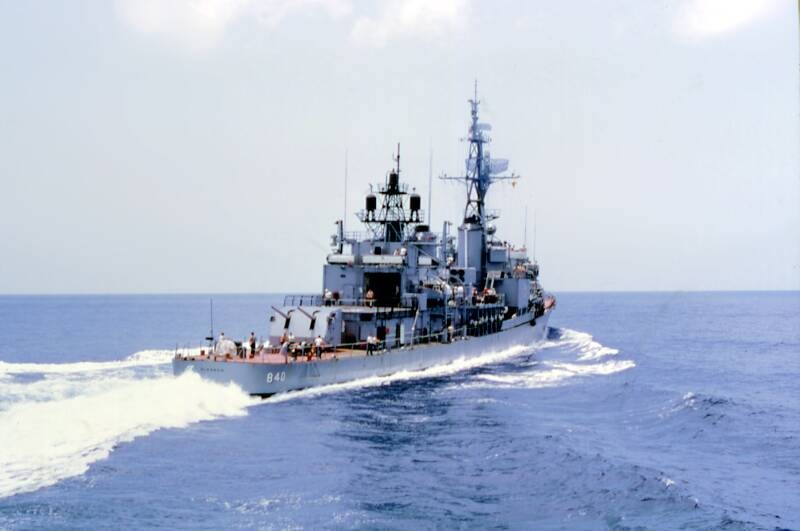
A familiar steamin'-mate - USS Glennon DD-840
Picture taken from Mullinnix near the Rosie Roads Piers - 1970
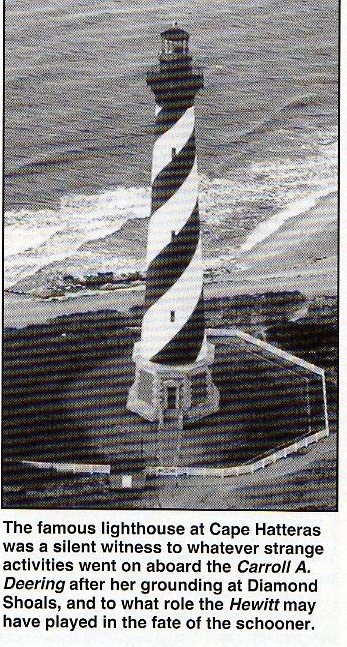
Cape Hatteras Lighthouse

1970 Cruise Book Cover
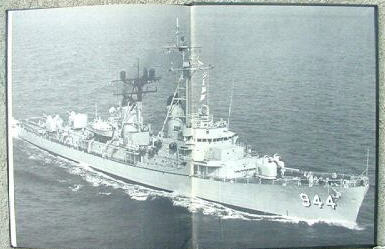
1970 Cruise Book Picture of Mullinnix
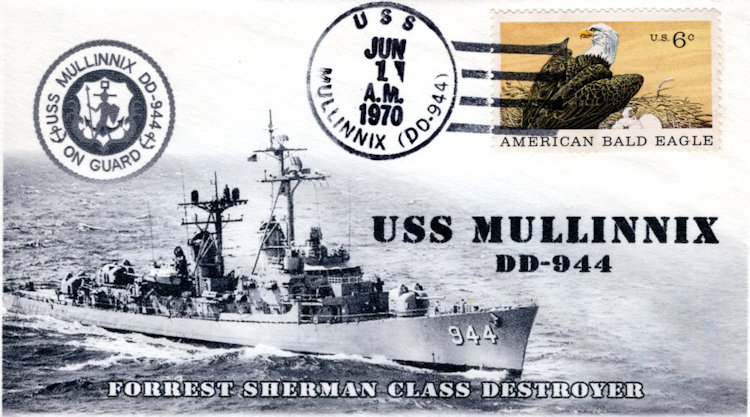
_______________
Excerpt from "The Last Gun Ship - History of USS Mullinnix DD-944"
A Historical Novel By Frank A. Wood
The ship deployed to the Mediterranean in April 1970, during the six months under the operational control of Commander, United States Sixth Fleet, the USS MULLINNIX cruised the Black Sea as well as the Mediterranean Sea. During this period ending in November 1970, the ship earned the Meritorious Unit Commendation. After returning to Norfolk (with the aircraft carrier USS Saratoga) the ship engaged in an extensive maintenance and training program which involved three weeks at sea training and special operations in the Caribbean Sea, as well as a four week dry docking period at Norfolk Naval Shipyard.
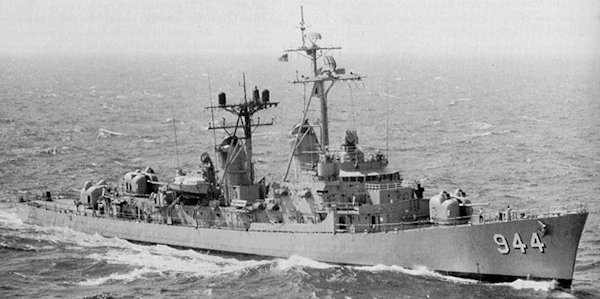
Picture taken in the Mediterranean on September 11, 1970. She retained her forward fixed Hedgehogs but had her 3-inch guns removed (forward). She was fitted with an SQS-23 sonar in place of her original SQS-4, but not in a bow dome; she has neither a clipper bow nor a bow anchor. Note, too, that her gun directors are in the original order, with the Mk 56 forward.
A constant turnover of personnel requires a constant training program. In the beginning of 1970, MULLINNIX went south to the warm waters of the Caribbean to conduct six weeks of training. After this training, she deployed to the Mediterranean and into the Black Sea. Although the MUX was never closer than forty miles to land, the crew did catch glimpses of the snow-capped Caucasus Mountains in the evening sunlight. Later during the same deployment, the MUX made a second trip into the Black Sea. During the cruise, MULLINNIX also visited Tunisia, Crete, Greece, Malta, and France.
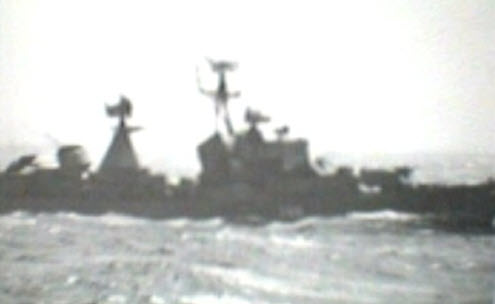
Russian Ship in Black Sea - 1970
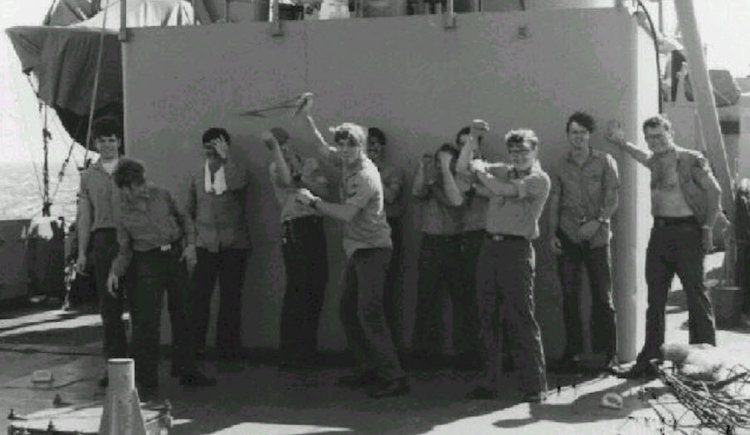
Radar Gang, Med Cruise, 1970
Left to right: Henry Berg, Dennis Bush, Unknown, Unknown, Dave Jones (with arm raised), Larry Baker (behind Dave Jones), Unknown (with fists raised), Jack Warburton (with face partially covered), Richard Papa, Alan Marion, and Dave Nerad.
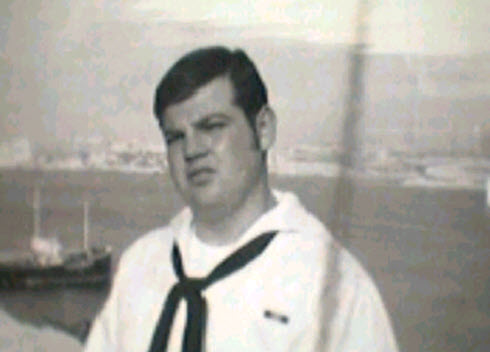
BMSN Al Thiebeau, 1970 Med Cruise
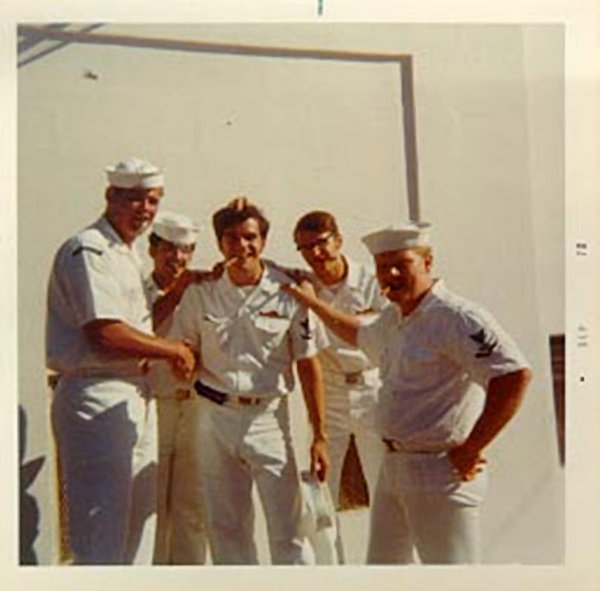
RM2 Dennis Bergeron being congratulated by 4 fellow RMs on the birth of his baby while in the Med
(Zimmerman "Zim" is on far left; Neil "Jewels" Appel is 2nd from left)

Mux waiting her turn to refuel
Note two tin cans ahead of Mux "unrepping"
Far off on the horizon to the left, are other ships unrepping as well
GO TO "Frank Wood Reports On Board" - 1970
GO TO Liberty Call Athens, Greece 1970
GO TO Liberty Call Beaulieu, France 1970
GO TO Liberty Call Valletta, Malta 1970
GO TO Liberty Call Pantelleria, Sicily 1970
GO TO Liberty Call Bizerte, Tunisia 1970
GO TO Liberty Call Souda Bay, Crete 1970
GO TO Liberty Call Alexandropolus, Greece 1970
GO TO Liberty Call Riposto, Sicily 1970
GO TO Liberty Call Cagliari, Sardinia 1970
GO TO Liberty Call Barcelona, Spain 1970
Go Back to Caribbean - 1970
Back to Ship History
Home
© 2004 by Frank Wood, All rights reserved





 HEN HE Was in Navy ROTC, Stephen F. Weston entertained thoughts of conning a destroyer. The idea recently became a reality when Lieutenant (jg) Weston qualified as Officer of the Deck on board USS Mullinnix (DD-944).
HEN HE Was in Navy ROTC, Stephen F. Weston entertained thoughts of conning a destroyer. The idea recently became a reality when Lieutenant (jg) Weston qualified as Officer of the Deck on board USS Mullinnix (DD-944).

 HERE’S LITTLE QUESTION about it: training aboard today’s sophisticated destroyer is difficult - "tougher than college (and) tougher than Officer Candidate School," believes LTJG Weston.
HERE’S LITTLE QUESTION about it: training aboard today’s sophisticated destroyer is difficult - "tougher than college (and) tougher than Officer Candidate School," believes LTJG Weston.

 NASMUCH AS EACH destroyer has its own OOD training program. Mullinnix officers are additionally required to complete schooling in antisubmarine warfare, firefighting, damage control, emergency ship-handling, and Rules of the Nautical Road.
NASMUCH AS EACH destroyer has its own OOD training program. Mullinnix officers are additionally required to complete schooling in antisubmarine warfare, firefighting, damage control, emergency ship-handling, and Rules of the Nautical Road.

 HILE STANDING CIC watches, LTJG Weston had to determine the course and speed of Mullinnix during fleet maneuvers, pilot the ship into port, anchor by radar, and operate air and surface search radar equipment. He also reported on procedures to be followed during simulated training exercises.
HILE STANDING CIC watches, LTJG Weston had to determine the course and speed of Mullinnix during fleet maneuvers, pilot the ship into port, anchor by radar, and operate air and surface search radar equipment. He also reported on procedures to be followed during simulated training exercises.



















